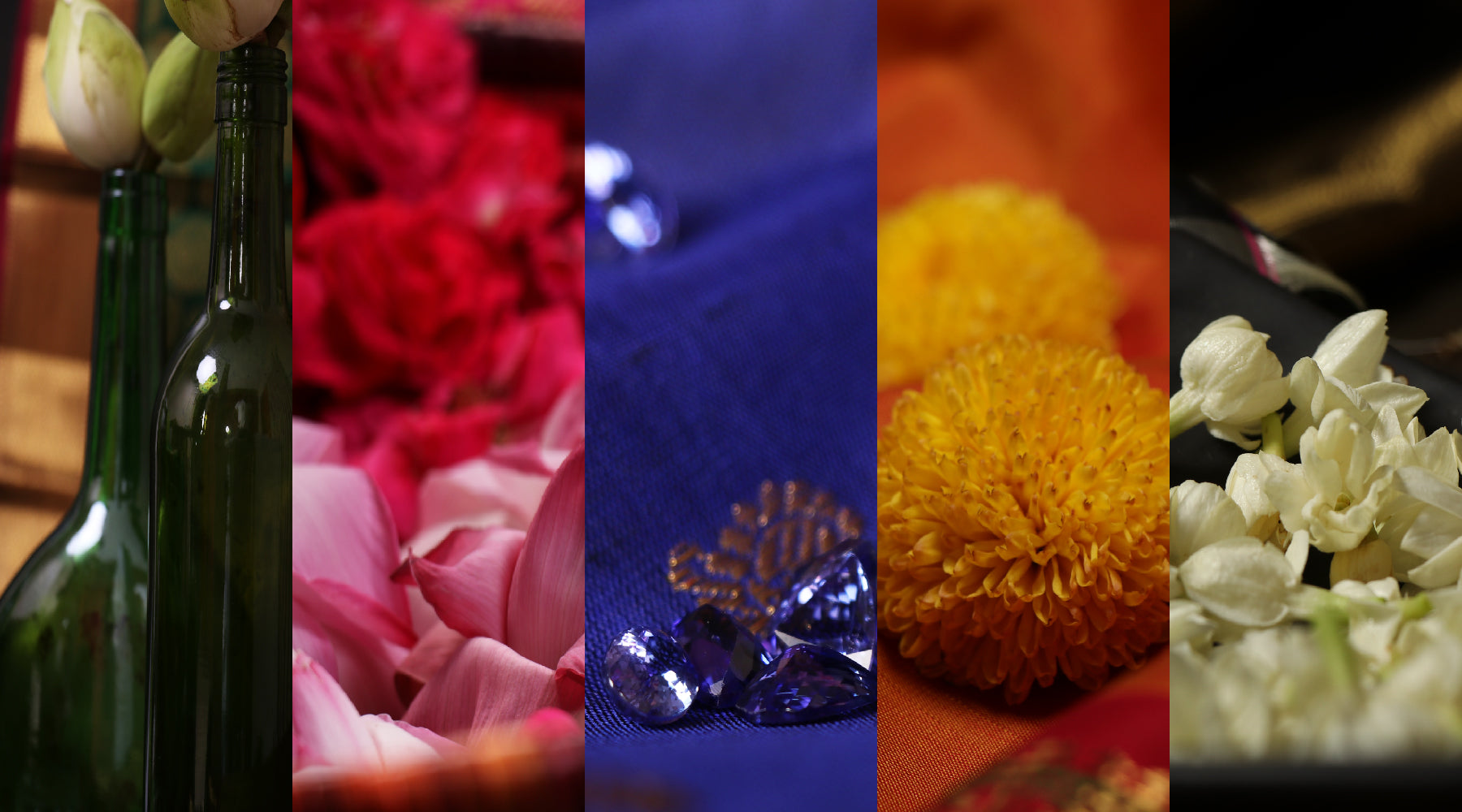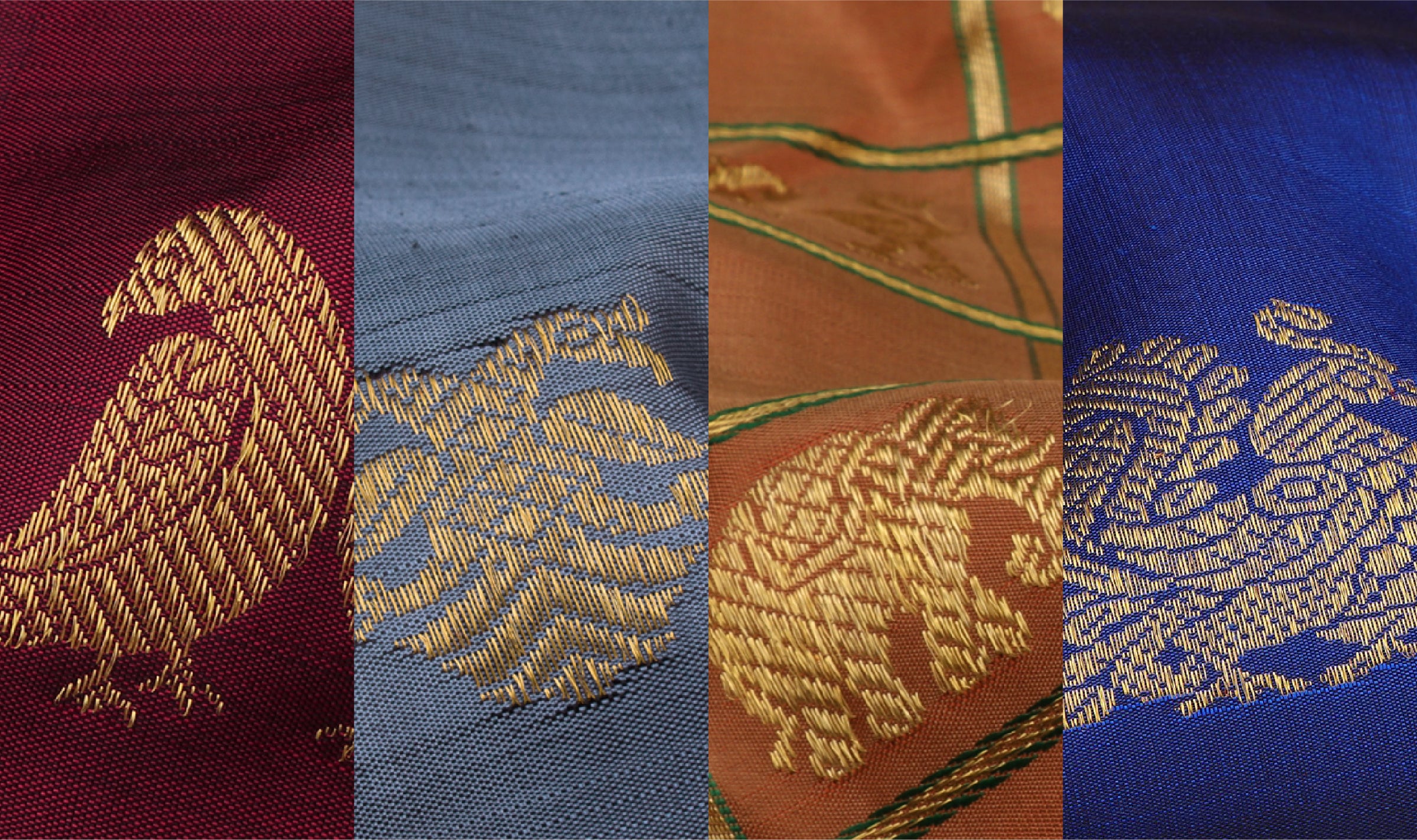Varna Sutra : Ratna Mudra - Bejewelled

Indian jewellery is as old as civilisation itself. Excavations of the ancient Indus Valley civilisation, in fact, yielded examples of beaded jewellery. In the art of adornment, Indians have used metals, precious stones and beads, shells, wood, ivory and much more. Jewellery was not a mere adornment; the materials used and the designs themselves were endowed with mystical qualities, and jewels offered protection from negative forces. The intriguing world of Indian jewellery also comes alive in other art forms, including the weaving of the kanjivaram, and in this edition of Varna Sutra, we delve into this source of creative inspiration.
WEAVE, ADORNED
The best illustration of the intricate mysticism and divinity ascribed to jewellery lies in the navaratna or the nine gems, unique to Indian ornamentation, which are still set and worn in a particular order sacred to the nine planets. Sundara kandam, the most recited module of the ancient epic poem Ramayana, is filled with richly detailed references to jewellery. This section describes the exchange of personal jewellery between Lord Rama and Sita through the messenger Hanuman. These deeply personal items of jewellery represented the depth of feeling between the separated husband and wife. At one point, Hanuman hands over a ‘kanaiyazhi’ or the signet ring of Lord Rama, and Sita in return parts with her ‘choodamani’ (a hair ornament), while she is in captivity in Lanka. Each piece of jewellery is described in detail, and holds an important place in this story that is narrated with fervour and auspiciousness in every part of India. Earlier in the tale, when Sita is abducted by the demon king Ravana, she leaves a trail of jewellery behind her, while airborne. The centrality of jewellery in this story is a reflection of its importance in Indian culture and legend.
The ‘seedhanam’ (gifts from a bride’s parents) to be given to a bride as part of her trousseau always includes gold jewellery. And our traditional jewellery from the South has a distinctive identity, just as our kanjivaram saris do. Artisans in ancient South India experimented with and perfected the art of jewellery decoration so much that in the twentieth century, we have not been able to improve much further on the classic patterns and exquisite workmanship. Every single ornament used by a South Indian woman from head to toe is unique to this part of the land.
The use of particular motifs in jewellery making and in ornamental designs on the sari carries the signature style of the region. The singular inspiration for both these crafts stems from temple architecture. The wall paintings and frescos found in the numerous temples down south depicting goddesses and women draped in saris ornamented with different patterns, exhibit a strong regional form and flavour.
The ancient Tamil classic Silappadikaram talks of a society dealing in gold, pearls and precious stones. Evidence from ancient history illustrates the use of woven fabrics held together at the waist with the help of an ornamental waist band called ‘kamarband’, either a piece of cloth or in the form of jewellery. Studies of Dravidian civilisation suggests the use of unstitched fabric lengths worn with pleats and gathers by both men and women. A waist ornament called ‘oddiyanam’, encrusted with stones set in gold, was used like a belt to hold up a sari.
The jewellery motifs used in a kanjivaram sari pay homage to the art of jewellery in South India, to our ancestors who conceived these jewels, and to the skilled artisans who handcrafted them. A South Indian bride’s trousseau traditionally includes these rich motifs as ornamentation, woven elaborately and holding within their intricacies a priceless heritage and an ancient culture. Here’s a look at the jewellery motifs used in a kanjivaram, evoking pleasure and delight in a sari connoisseur, whether for a traditional ceremony or for everyday wear.
Jadai Nagam

There are three important hair ornaments that define the elaborate ornamentation of a bride in Tamil Nadu. Referred to as ‘thalai samanam’ (ornaments for the head), the ‘chandra pirai’ and ‘surya pirai’ adorn the two sides of the hair parting at the front, while the circular ‘rakkodi’ sits at the back of the head, followed by a ruby and diamond studded divine cobra form known as the ‘jadai nagam’ (literally meaning hair serpent). These jewels, initially adapted by the Devadasis or the temple dancers, are still a part of the head ornamentation of Bharatanatyam dancers today.
The top portion of the jadai nagam is shaped like a snake’s hood and this part is depicted as a stylised floral design in the kanjivaram sari border. The motif goes beyond the visual, signifying the symbolic spiritual power of ‘kundalini’ lying within each person.
Muthu Kattam - Pearl checks

Pearls, the gems of the ocean, were held in high regard, more so than diamonds and rubies, and used in the adornment of royal kings and queens. The milky white pearl, one of the richest gifts of nature, was the most traded commodity on the Tamil Nadu coast. The coastal area of Southern India, which extended from the ports of Thoothukudi (Tuticorin) to Kanyakumari (the Gulf of Mannar), was referred to as the Pearl Fishery coast in maritime history. South India was famous for its pearl exports and this formed part of the main revenue for various kingdoms and colonies. In this design, tiny white dots resembling pearls are woven as kattams or checks by extra weft either in white silk thread or zari throughout the body of the sari, lending it a delightful shimmer.
Vaira Oosi - Diamond needle

The vaira oosi refers to the fine, needle-thin lines that run parallel to the borders and selvedge of a kanjivaram. This pattern runs all over the warp of the sari, along its entire length, adding glitter and texture to the drape. The parallel lines of fine zari interspersed with the colour of the body make it a truly splendid sight, the sheen and lustre spelling sheer luxury.
Neli / Rettai Neli

Neli is the pattern of the toe-ring or ‘metti’, which is placed on the bride’s toes during the marriage ceremony. The wavy double lines also adorn our floors as border designs in the kolams drawn in our houses. In a kanjivaram sari, this design is depicted as a single or double wavy line. If there is a dot inside the bends of the line, it is referred to as ‘veldhari’. The neli designs are stunning when they run all across the body of a kanjivaram. They are also woven as an accompaniment to the main thematic motif of the sari on the borders and pallu.
Pavunpet - Gold sovereign pettu

Pavunpet is the beautiful design of a gold coin, represented in four directions of a quadrant by ‘V’ lines. Though it looks similar to the rudraksham motif, pavunpet has a dot in the centre of the coin and is accompanied by two vertical lines on either side of the ‘pavun’ or coin. The larger ‘pavun’ motif set in a double-pet border of a kanjivaram sari is one of the most recognised patterns in the craft. Small circular buttis are sometimes woven throughout the body of the sari, and are referred to as coin buttas.
Vairam - Diamond pattern

This geometric design is characterised by a rhombus form with four sharp corners, corresponding to the shape of a diamond. The intricate design enhances the border and pallu compositions of the kanjivaram sari, forming broad bands.
Salangai - Anklet design

A literal translation of salangai is the bell anklet worn by dancers. Crafted in silver and worn by a woman on her feet, this everyday ornament has small droplets and tiny bells that delicately announce her arrival. On a kanjivaram sari, this pattern is depicted by a row of floral patterns, completing a linear border.
Vanki - Armlet

While armlets called ‘bajuband’ are worn in different parts of India, the vanki (armlet) of South India is unique because of its inverted V-shaped design. From old paintings and cultures, it appears that its origin is traced to Naga or snake worship. The motif has angular lines closely placed to form an armlet pattern on the border of the sari.
The unique depiction of traditional jewellery on the beautiful drape of the kanjivaram reflects both the myriad sources of inspiration for the embellishment of a sari, as well as the craftsmanship and creativity of the weaver. Whether a literal representation or a more symbolic interpretation of a precious stone or a piece of jewellery, the forms come alive beautifully on the sari.
- Research by Sreemathy Mohan, edited by Aneesha Bangera



